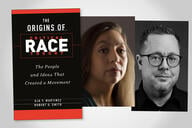You have /5 articles left.
Sign up for a free account or log in.
Technological innovations in the 21st century have enabled researchers to collect and process data about human behavior at an unprecedented scale, but are social scientists keeping up?
In his book Bit by Bit: Social Research in the Digital Age (Princeton University Press), Matthew Salganik, professor of sociology at Princeton University, discusses how new data opportunities are shaping modern social science. But the book is not just a discussion of a changing field -- it is also a practical guide for teaching modern computational methods for collecting and analyzing observational and experimental data.
Designed to appeal to social scientists with an interest in modern techniques, and data scientists with no social science background, elements of the book are already being used at some colleges to teach students how to make the most of big data. Salganik answered the following questions about his book, published earlier this month, by email.
Q: At the beginning of the book you describe social research as in “transition.” What did you mean by this?
A: The central premise of Bit by Bit is that the digital age creates new opportunities for social research. Researchers can now observe behavior, ask questions, run experiments and collaborate in ways that were simply impossible in the recent past. The source of these new opportunities is the transition from the analog age to the digital age. This transition has not happened all at once, and in fact, it’s not yet complete. However, we've seen enough by now to know that something big is going on.
Q: How do you think social research might change in future?
A: I think the biggest change that is still to come is that much of the tracking and experimentation that we associate with online behavior will increasingly apply to our offline behavior. That is, right now, many researchers are aware that all our behavior online is tracked and subject to experimentation. For example, when you visit Amazon, they are recording and analyzing your browsing behavior, and they are running experiments to improve their business metrics. However, increasingly, more and more of these same things will happen with our off-line behavior because of so-called ubiquitous sensing and the internet of things. For example, physical stores are increasingly investing in similar data collection and experimentation infrastructure. So, right now, when many people think about social research in the digital age, they think about online behavior, but increasingly it will include all of our behavior, online and off-line.
Q: What audience did you have in mind when you were writing Bit by Bit?
A: Bit by Bit is for social scientists who want to do more data science, data scientists who want to do more social science, and anyone interested in the hybrid of these two fields. Because of this diverse audience, I’ve tried to fill it with examples and avoid academic jargon, either from social science or data science. The book is already being used in university courses at many different levels -- undergraduate, master’s and Ph.D. -- and in many fields, including sociology, political science, communication, information science and computer science. To make it easier for people that want to teach a class using Bit by Bit, I’ve created a collection of teaching materials, including syllabi and slides from my courses and others. In addition to students at universities, I hope the book will also be helpful to people in companies, governments and NGOs, because they are also excited about harnessing the power of the digital age for social research.
Q: What are some misconceptions people have about big data?
A: From data scientists, a common misconception is to think that more data alone can solve all problems in social research. From social scientists, I’ve often seen something of the opposite misconception: that new forms of data will not help at all, because they are different from the kinds of data sources that social scientists have used in the past. What I’ve tried to do in Bit by Bit is to help each group see what it has to contribute and what it has to learn.
Q: How equipped are social science graduates to work with big data?
A: Increasingly, some social science graduates are prepared to work with big-data sources. This is in part through specialized courses and summer training programs, such as the Summer Institute in Computational Social Science and Data Science for Social Good. But these kinds of specialized activities are not at the scale we need to provide all students with the training that is required. Therefore, I think we’ll see even more progress as this training becomes a routine part of undergraduate and graduate training that students receive.
Q: The book places a lot of emphasis on the importance of ethics in modern social research design. Why is this so important?
A: There is a fundamental tension that runs through a lot of social research in the digital age. Researchers -- often in collaboration with companies and governments -- have increasing power over the lives of participants. By power, I mean the ability to do things to people without their consent or even awareness, such as track their behavior or enroll them in experiments. As the power of researchers is increasing, there has not been an equivalent increase in clarity about how that power should be used. In fact, researchers must decide how to exercise their power based on inconsistent and overlapping rules, laws and norms. This combination of powerful capabilities and vague guidelines can force even well-meaning researchers to grapple with difficult decisions. If researchers are going to be able to take advantage of their new power, we must figure out how to use this power responsibly. Bit by Bit tries to help people think about both what we can do and what we should do.
Q: Insights from big data can be extremely valuable to companies. How are these corporate interests shaping social research?
A: There are some academics who are worried about the role that tech firms are playing in academic research and training. But I think that when organized correctly, collaboration between academics and companies can produce great benefits for everyone. In fact, because I think this kind of academic-industrial collaboration is so important and will enable exciting new research, Bit by Bit includes advice to academics about how to establish these kinds of collaborations.




